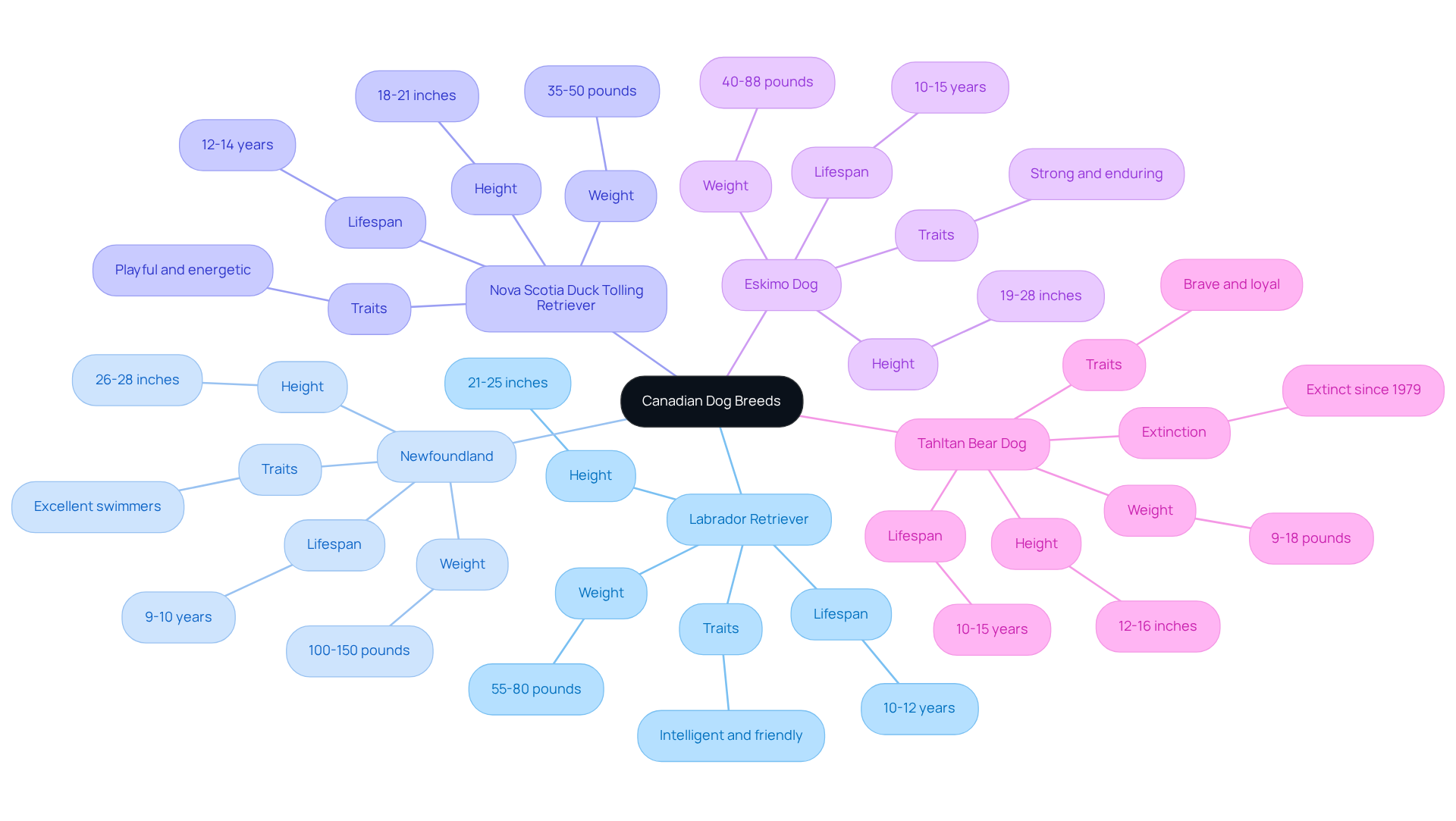Understanding Canadian Dog Breeds: Origins, Traits, and Significance
Overview
This article lovingly explores the origins, traits, and significance of Canadian dog breeds, shining a light on their unique characteristics and historical roles within Canadian society. It highlights how breeds like the Labrador Retriever and Newfoundland not only adapt beautifully to diverse environments but also hold vital places in our cultural heritage and companionship. This reflects the profound bond between Canadians and their beloved dogs, reminding us of the joy and warmth our furry family members bring into our lives.
Introduction
Canadian dog breeds are more than just beloved pets; they represent a rich tapestry of history, culture, and resilience that mirrors the diverse landscapes of their homeland. These unique breeds, with traits honed over generations, have played vital roles in the lives of Indigenous communities and early settlers, serving as loyal companions and essential working partners.
As we navigate the complexities of modern pet ownership, we must consider how to preserve and appreciate these remarkable breeds. How can we ensure that your furry family members continue to thrive in our ever-changing world? Together, we can explore nurturing solutions that honor their legacy.
Define Canadian Dog Breeds
Canadian dog breeds include those types that have emerged in this beautiful country, each noted for their distinctive traits and historical significance. The Canadian Kennel Club recognizes five unique Canadian dog breeds that proudly represent Canada:
- Labrador Retriever
- Newfoundland
- Nova Scotia Duck Tolling Retriever
- Eskimo Dog
- Tahltan Bear Dog
These Canadian dog breeds have evolved characteristics that are well-suited to the diverse Canadian environment, highlighting the adaptability and resilience of our furry family members across various climates and terrains.
For example, Labrador Retrievers typically weigh between 55-80 pounds and stand 21-25 inches tall, with a life expectancy of 10-12 years. Newfoundlands, celebrated for their remarkable swimming abilities, can weigh between 100-150 pounds and stand 26-28 inches tall. The Nova Scotia Duck Tolling Retriever, the smallest of the retriever types, is known for its playful demeanor and exceptional hunting skills.
The Eskimo Dog, historically vital for sledding and hunting, embodies strength and endurance, with a height range of 19-28 inches and a weight range of 40-88 pounds. Sadly, the now-extinct Tahltan Bear Dog was cherished for its bravery and hunting prowess, but its decline was influenced by factors such as a distemper outbreak and the introduction of firearms.
As Ian Lynch wisely noted, “It’s important to take some time to celebrate our wonderful Canadian varieties.” The CKC continues to emphasize the importance of preserving Canadian dog breeds, reflecting both their cultural significance and the need for responsible propagation practices. As we look toward 2025, the CKC acknowledges these Canadian dog breeds, highlighting their invaluable contributions to Canada’s rich canine heritage. Together, let us cherish and nurture the unique qualities of these breeds, ensuring they remain a beloved part of our lives.

Contextualize the Importance of Canadian Dog Breeds
The cultural and historical fabric of our nation beautifully incorporates Canadian dog breeds, reflecting the diverse geography and lifestyles of its people. Over centuries, these breeds have been vital to early settlers and Indigenous communities, serving as working dogs, loyal companions, and symbols of national pride. Take the Labrador Retriever, for instance, celebrated as the most popular breed in Canada. Its friendly nature and adaptability make it a beloved companion across the country. Similarly, the Eskimo Dog represents the heritage of the Arctic peoples, embodying resilience and adaptability in the face of challenges.
In total, nine distinct Canadian dog breeds originated in Canada, each contributing uniquely to our rich cultural tapestry. These breeds not only enhance our lives—whether through hunting, herding, or companionship—but also serve as a testament to the emotional and mental health benefits that dogs provide. They reinforce the vital role canines play in our modern Canadian society, reminding us of the joy and comfort our furry family members bring into our lives.

Explore the Historical Origins of Canadian Dog Breeds
The historical roots of Canadian dog breeds are deeply intertwined with Indigenous communities, who relied on these breeds for essential activities like hunting and transport. Take, for example, the Eskimo Dog, which was lovingly developed by the Inuit to thrive in the harsh Arctic conditions. This remarkable breed served not only as a sled dog but also as a trusted hunting partner, with a rich history that spans over 4,000 years. Their role was vital for survival in extreme environments, showcasing loyalty and resilience. It’s important to note that some Canadian dog breeds, like the Canadian Eskimo canines, are typical working animals—devoted to their owners but not necessarily suited for cuddling on the couch.
Similarly, the Newfoundland breed is one of the Canadian dog breeds that emerged from a blend of local dogs and those brought by European settlers, evolving into extraordinary water rescue companions and steadfast friends for fishermen. Recognized officially as a separate breed by the AKC in 1886, Newfoundlands have a legacy of nurturing and supporting their human counterparts. These Canadian dog breeds have beautifully adapted to their environments, reflecting unique traits shaped by their roles in Indigenous cultures. The influence of Indigenous peoples on Canadian dog breeds is evident in their physical characteristics, temperaments, and working abilities, highlighting a profound bond that has shaped Canada’s canine heritage.
As we reflect on this rich history, it’s heartwarming to consider how these connections continue to inspire the nurturing environments we create for our pets today.
Identify Key Characteristics of Canadian Dog Breeds
Canadian dog breeds showcase a remarkable array of characteristics that reflect their adaptation to the diverse Canadian climate and lifestyle. Take the Newfoundland, for example. This gentle giant, distinguished by its large size, webbed feet, and thick double coat, is not only an exceptional swimmer but also a reliable water rescuer. Weighing up to 150 pounds, Newfoundlands are cherished family companions. Regular grooming is essential for them, with brushing recommended two to three times a week to maintain their coat’s health.
Similarly, the Labrador Retriever is celebrated for its friendly disposition, intelligence, and versatility. These lovable dogs excel in both family settings and service roles. With a height reaching up to 24.5 inches, Labradors are adaptable and flourish in diverse environments, contributing to their reputation as one of the most favored breeds globally.
The Nova Scotia Duck Tolling Retriever stands out for its agility and playful nature, making it an ideal choice for active families. This medium-sized retriever is known for its hunting prowess and energetic demeanor, requiring regular exercise to maintain its health and happiness. Meanwhile, the Canadian Eskimo Dog, recognized for its strength and endurance, thrives in cold environments, even in sub-zero temperatures. This remarkable breed can cover up to 40 miles a day, equipped with a thick coat that shields it from severe weather conditions.
Veterinarians emphasize the importance of understanding these breeds’ unique traits to ensure their well-being. For instance, Cindy Elston observes that Eskimo Dogs need considerable physical exercise and firm guidance, especially in homes with multiple dogs, to avoid behavioral problems. Additionally, regular grooming tasks for Eskimo Dogs include nail trims, ear cleanings, and dental care, which are crucial for their overall health.
Overall, the modifications of these types of Canadian dog breeds not only serve practical functions but also enhance their popularity among dog enthusiasts, reflecting their essential role in the culture of Canada. By nurturing an understanding of these breeds, we can create a loving environment for your furry family members.

Highlight Notable Examples of Canadian Dog Breeds
Among the most cherished Canadian dog breeds, the Labrador Retriever shines brightly as a beloved companion, not just in Canada but around the world. Known for its friendly demeanor and intelligence, the Labrador excels in various roles, including therapy, assistance, and search-and-rescue operations. This breed has proudly held its title as the most favored dog in the country for 26 consecutive years, treasured for its loyalty and adaptability in family settings. With approximately 7.7 million pet dogs in Canada, the Labrador Retriever’s popularity plays a significant role in the nation’s pet ownership landscape, making it a perfect addition to your furry family members.
Equally impressive is the Newfoundland, often lovingly referred to as the ‘gentle giant.’ This breed is celebrated for its remarkable swimming ability and has a rich history of performing heroic rescues, saving lives from drowning incidents. Newfoundlands are not only appreciated for their physical prowess but also for their gentle temperament, which makes them wonderful family pets. Their thick fur provides the essential warmth needed to thrive in the chilly winters of Canada, ensuring they remain cozy in any environment.
Furthermore, the Eskimo Dog, with its sturdy physique and stamina, has played an essential role in Inuit culture for centuries, serving as a sled dog and hunting partner. Each of these breeds reflects the rich canine heritage of Canada, showcasing their unique traits and the significant roles they play in our lives. Notably, the Labrador Water Dog is a unique member of Canadian dog breeds, recognized for its swimming ability and resistance to cold, further enriching the conversation. As you consider adding one of these wonderful companions to your home, remember that they not only bring joy but also a nurturing environment for your family.

Conclusion
The exploration of Canadian dog breeds reveals a rich tapestry of history, adaptability, and cultural significance. These breeds not only embody the spirit of Canada but also reflect the diverse environments and lifestyles that shape their unique characteristics. Each breed, from your friendly Labrador Retriever to the resilient Eskimo Dog, contributes to the nation’s identity and showcases the deep bond between humans and canines.
Throughout this article, we have highlighted key insights into the origins, traits, and roles of various Canadian dog breeds. The historical connections to Indigenous communities, their practical adaptations to harsh climates, and the emotional benefits these companions bring to families all underscore the importance of preserving these breeds. By celebrating their unique traits and understanding their needs, we foster a nurturing environment for them, ensuring they continue to thrive in Canadian homes.
Recognizing the significance of Canadian dog breeds goes beyond mere appreciation; it invites a commitment to their preservation and responsible care. As these breeds continue to enrich our lives, they remind us of the deep emotional connections we share with our furry family members. Embracing this responsibility not only honors their legacy but also strengthens the cultural fabric of Canada, ensuring that future generations can enjoy the companionship and joy these remarkable dogs bring into our lives.
Frequently Asked Questions
What are the recognized Canadian dog breeds?
The Canadian Kennel Club recognizes five unique Canadian dog breeds: Labrador Retriever, Newfoundland, Nova Scotia Duck Tolling Retriever, Eskimo Dog, and Tahltan Bear Dog.
What are the characteristics of the Labrador Retriever?
Labrador Retrievers typically weigh between 55-80 pounds, stand 21-25 inches tall, and have a life expectancy of 10-12 years.
What makes Newfoundlands notable among Canadian dog breeds?
Newfoundlands are celebrated for their remarkable swimming abilities, weighing between 100-150 pounds and standing 26-28 inches tall.
How does the Nova Scotia Duck Tolling Retriever differ from other retrievers?
The Nova Scotia Duck Tolling Retriever is the smallest of the retriever types, known for its playful demeanor and exceptional hunting skills.
What is the historical significance of the Eskimo Dog?
The Eskimo Dog was historically vital for sledding and hunting, embodying strength and endurance, with a height range of 19-28 inches and a weight range of 40-88 pounds.
Why is the Tahltan Bear Dog no longer present?
The Tahltan Bear Dog is now extinct, having declined due to factors such as a distemper outbreak and the introduction of firearms.
How do Canadian dog breeds reflect the culture and history of Canada?
Canadian dog breeds reflect the diverse geography and lifestyles of Canada, serving as working dogs, loyal companions, and symbols of national pride, integral to early settlers and Indigenous communities.
What role do Canadian dog breeds play in modern society?
Canadian dog breeds enhance lives through hunting, herding, and companionship, providing emotional and mental health benefits and reinforcing the vital role of canines in Canadian society.







